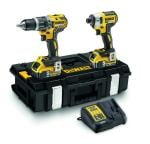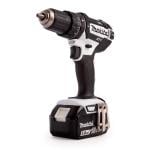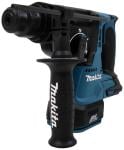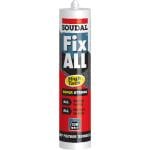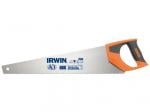Drilling Holes in Tiles (How To)
Drilling holes into tiled walls is a fairly straightforward task, but there is a right and a wrong way to do it. It’s not quite as simple as drilling a hole into a wall to hang a shelf – there are several things that you need to be aware of before diving straight in unless, of course, you feel like having to have the entire bathroom retiled! OK, perhaps it’s not thatdramatic, but something as simple as using the wrong drill bit can be disastrous. That, and if you are planning on hanging a medicine cabinet or a soap dish, for example, you’ll need to understand how to drill through the substrate behind the tiles in such a way that doesn’t cause any damage – or indeed make it too weak to support the wall anchor. Here’s everything you need to know:
How to Drill Through Tile (A Step by Step Guide)
Step – 1: Identify The Kind of Tile You Are Drilling Into
A tile is a tile is a tile. Wrong! There are three different kinds of tile to look out for:
- Glazed ceramic: is the most common tile and what you’ll typically find in most older homes. Glazed ceramic is the easiest to drill through
- Glass: glass tile is typically used more as an accent in tiled rooms and is a relatively new type of tile – this will require a slightly different approach
- Porcelain: looks practically identical to glazed ceramic tile, though don’t be fooled – it’s a lot harder to drill through.
Step – 2: Select The Appropriate Drill bit
Don’t rush in with just any old drill bit. Here’s what you’ll need:
- Glazed ceramic: glazed ceramic tiles can be drilled with a carbide bit
- Glass: can be drilled with a diamond-tipped drill bit
- Porcelain: will also need to be drilled using a diamond-tipped drill bit.
Understandably – “diamond-tipped” sounds expensive but you’ll be pleased to learn that these bits are surprisingly cheap. When in doubt, your best bet is to buy the diamond-tipped drill bits as they will drill through any type of tile with ease.
Step – 3: Prepare the Tile Wall for Drilling
Next up, it’s time to prepare the tile wall for drilling. You’re going to have to get your measurements right. Do this several times and ensure that they are precise to avoid any complications.
- You can add masking tape to the target area on the tiled wall where you plan to be drilling. – Plus it’s easier to mark the hole on tape rather than on tile
- Make sure that you use a level to ensure that the drilled holes are perfectly aligned (nobody wants a wonky towel bar) Check out our online store where we have levels, laser levels and optical levels.
- Ideally, you’ll want to drill your holes as close to the centre of the tile as possible as the edges will crack far more easily. Bear this in mind when measuring up where you want to hang any hardware on a tile.
Step – 4: Take It Slow
- Drilling slowly is drilling 1-0-1 – take your time and make sure that the hole ends up where you want it to be
- Fortunately, having masking tape on the wall to mark where you’re drilling will also help to prevent the drill bit from skidding around
- Once you have successfully drilled the first part of the hole and you are going in straight, you can increase the speed if you like – but keep it steady
- With steady pressure and a medium speed, you can successfully drill a hole through tile without damaging the tile, the drill bit, or overheating.
Step – 5: Finish Off With Some Speed
Once the drill bit drills through the tile you will feel a noticeable change in resistance. At this point, you can speed the drill up, whilst applying less pressure. This will then help to extend the drill bit into the drywall/backer board with minimal damage. Then, safely remove the drill bit from the hole and voila!
What if I Need to Drill a Large Hole in Tile?
If you need to drill a larger 2-inch hole into tile, say for example for a plumbing stub-out, and you don’t want to use a hole-saw, there is an alternate method:
- Outline the hole that you wish to drill into the tile (this can be done using a grease pencil or felt-tip – or indeed using masking tape)
- Following that, using a ¼” masonry bit, you can drill a series of holes around the circle, closely spaced together. Next, take a hammer and very gently tap along the ring of holes
- Be patient with this as it may take several minutes before the centre of the hole will successfully break free. Certainly, the edge of the hole will be rough but this can easily be disguised using a decorative cover such as an escutcheon plate.
Conclusion
As long as you follow the guidelines closely, you shouldn’t have any issues drilling into any tile. As we mentioned at the beginning of the article, it’s a relatively straightforward process that simply requires a little patience, process, and finesse. We hope that you have found this article helpful and wish you the best of luck with your project!



